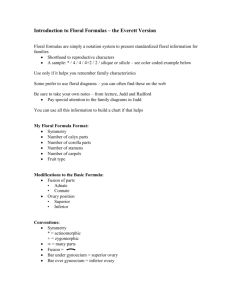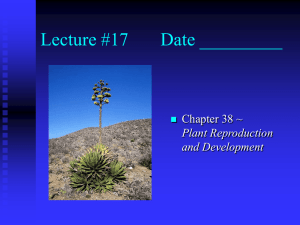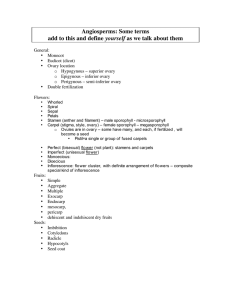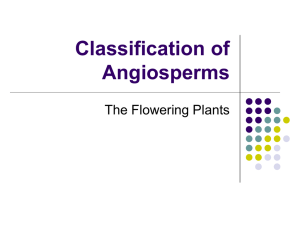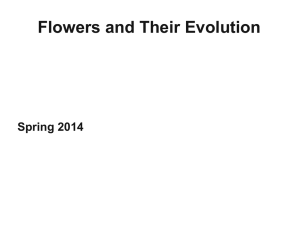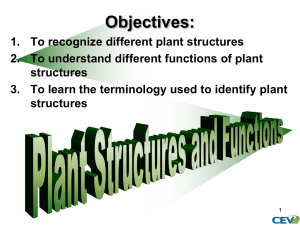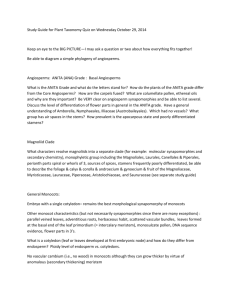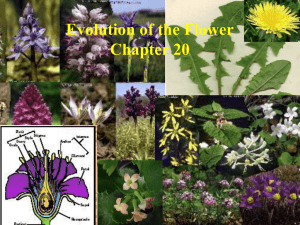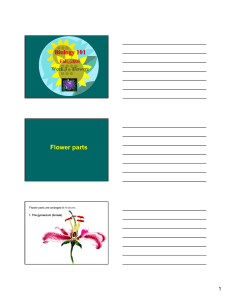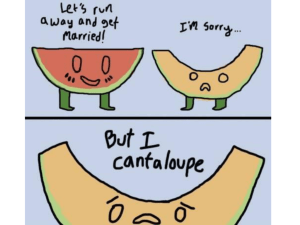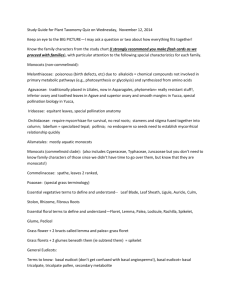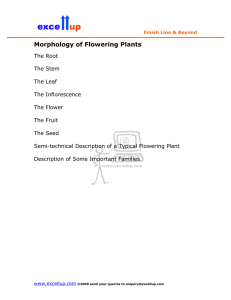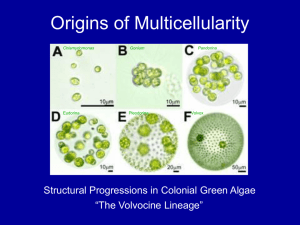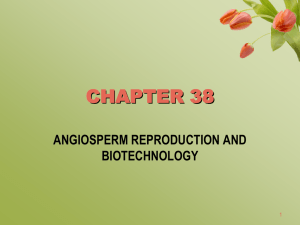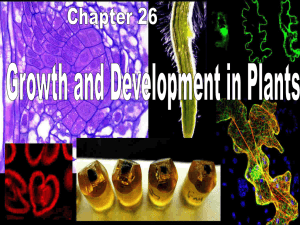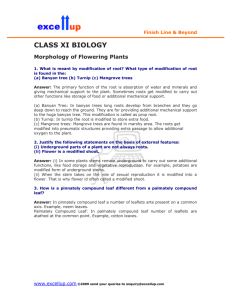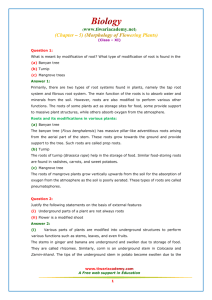Morphology of flowering plants
advertisement
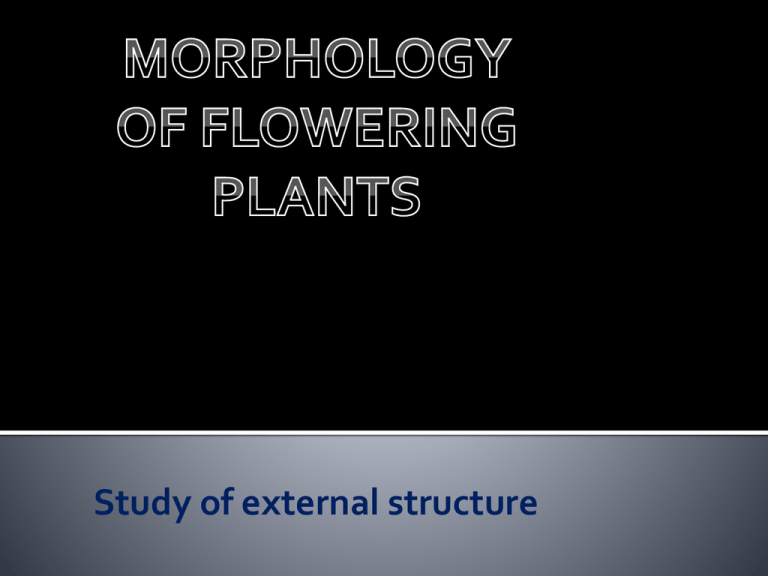
Study of external structure Primary root develops from radicle Produce secondary, tertiary roots etc Tap root system- primary roots and its branches Fibrous root system- wheat Adventitious root systemother functions- banyan tree Prop roots- banyan tree Stilt root- sugar cane Pneumatophores- mangroves Nodes and internodes Absorption of water and minerals, conduction anchorage, storage, protection, spreading out leaves, flowers etc Underground stem modification for food storage- potato, ginger etc Axillary buds to thorns as in Citrus Photosynthesis- cactus Spreading- grass, chrysanthemum Vegetative propagation- pistia From node for photosynthesis Leaf base, petiole and lamina In monocotyledons-sheath Pulvinus – in leguminous plants Veins are the channels for conduction Arrangement of veins and veinlets parallel Simple- china rose Palmately compound leaf -cotton Pinnately compund leaf -neem Pattern of arrangement of leaves Alternate- china rose Whorled- alstonia Opposite- guava Tendrils- peas Spines- cactus Acacia- stem modified for photosynthesis Food storage- onion insectivorous Flower- modified shoot Arrangement of flowers- inflorescence Cymose- jasmine Recemose- ceasalpinia Reproductive unit Four whorls on thalamuscalyx, corolla, androecium and gynoecium Reproductive- androecium, gynoecium perianth Acessory- calyx and corolla symetry Actinomorphic- chilly, datura Zygomorphic- pea, cassia Asymmetric- canna Bracteate, ebracteate Trimerous, tetramerous or pentamerous epigunous- sunflower Perigynous- rose Corolla- coloured,peltals, gamo/polypetalous Calyx- sepals, green, protection, gamosepalous/polysepalous aestivation Valvate- calotropis Twisted- cotton Imbricate-cassia Vexillary/papilonaceouspea Arrangement of sepals or petals in floral bud Composed of stamens Filament and anther Staminode- sterile stamen Epipetalous- attached to petals Epiphyllous- attached to tepals Polyandrous- remain free United into one bunchmonoadelphous- china rose Polyadelphous- citrus Two bundles- pea Varying length- salvinia Made up of carpels Carpel- style, stigma and ovary Ovary bears placenta- ovules Apocarpous- carpels free syncarpous- carpels united Placentation- arrangement of ovules Marginal- pea Parietal-mustard Free central- primrose Basal- sunflower Parthenocarpic fruit- formed without fertilization- banana Mature ripened ovary Pericarp- walls of fruit, fleshy or dry Dry pericarp- epicarp, mesocarp, endocarp- coconut, mango Ovules develop into seeds Seed coat and embryo Embryo- monocotyledon or dicotyledon Seed coat – testa and tegmen Embryoembryonal axis and two cotyledons endosperm Dicotyledonous seed Hilum- scar where seed attached to fruit Micropyle- small pore Embryonal axisradicle and plumule monocotyledonous seed Seed coat – fused with fruit wall Endosperm bulky Plumule is covered by coleoptile Aleuron layerseparates endosperm and embryo One cotyledonscutellum Radicle is covered by coleorhiza Floral formulaBr- bracteate K- calyx C- corolla P- perianth A- androecium G- gynoecium bisexual G – superior ovary G- inferior ovary G - half inferior male female actinomorphic zygomorphic K(5) C(5)A5 G(2) K5 C5A(10) G5 Earlier called Papilionoideae, sub family of Leguminosae Distributed world over Trees, shrubs,herbs, root with root nodules Erect stem or climber Leaves: alternate, pinnaltely compund or simple, leaf base pulvinate, stipulate, reticulate Floral characters Recemose inflorescence Flower- bisexual, zygomorphic Calyx- sepals five, gamosepalous, imbricate aestivation Corolla- petals 5, polypetalous, papilionaceous, vexillary aestivation Androecium- ten, diadelphous, anther dithecous Gynoecium- superior, monocarpellary, unilocular, with may ovules Fruit: Legume, many seeded Floral Formula Economic importance: pulses- gram, moong, soyabean: Edible oil- soyabean, ground nut Dye- Indigofera Fibres- sunhemp Fodder- sesbania Ornamentals- sweet pea Medicine- muliathi Called potato family Distributed everywhere Herbs, shrubs, rarely trees Herbaceous stem, hairy or glabrous Leaves: alternate, simple, exstipulate, reticulate Food- tomato, brinjal, potato Spice- chilli Medicine- belladona Fumigatory- tobacco Ornamentals- petunia Called lily family- monocotyledons Distributed everywhere Perennial herbs with underground bulbs c Herbaceous stem, hairy or glabrous Leaves: alternate, simple, exstipulate, reticulate
